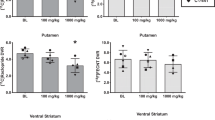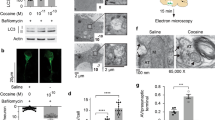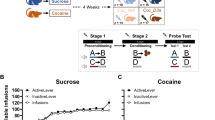Abstract
Previously we found that outbred male Sprague–Dawley rats can be classified as either low or high cocaine responders (LCRs or HCRs, respectively), based on their open-field locomotor response to acute cocaine (COC; 10 mg/kg, i.p.). Here, we extended this analysis to amphetamine (AMPH; 0.5, 1, and 5 mg/kg, i.p.) and found that the individual differences in behavioral activation were not as pronounced as with COC. This was confirmed with observational analysis of behaviors. Differences in drug-induced activation could involve differential dopamine transporter (DAT) function/trafficking. To address this possibility, we measured [3H]DA uptake into dorsal striatal synaptosomes prepared from rats injected 30 min earlier with saline, COC, or AMPH to determine DAT activity, and radioligand binding to determine the total number of DATs. Striatal [3H]DA uptake in COC-treated HCRs was significantly higher than in LCRs. Furthermore, regardless of LCR/HCR classification, uptake in individual COC-treated rats was significantly correlated with their locomotor behavior in the 30 min after drug administration. In contrast, AMPH-treated rats did not differ in uptake, nor were uptake and locomotor activity correlated. DAT number did not differ between LCRs or HCRs, or between AMPH-treated rats. In addition, when individual differences in COC-induced behavior were no longer detected in LCRs and HCRs 1 week after initial classification, uptake was also similar. Together, these results suggest that a difference in expression of functional DATs on the cell surface contributes to the individual differences observed in COC-induced, but not AMPH-induced, behavioral activation of rats.
Similar content being viewed by others
Log in or create a free account to read this content
Gain free access to this article, as well as selected content from this journal and more on nature.com
or
References
Benuck M, Lajtha A, Reith ME (1987). Pharmacokinetics of systemically administered cocaine and locomotor stimulation in mice. J Pharmacol Exp Ther 243: 144–149.
Bevins RA, Klebaur JE, Bardo MT (1997). Individual differences in response to novelty, amphetamine-induced activity and drug discrimination in rats. Behav Pharmacol 8: 113–123.
Bradford MM (1976). A rapid and sensitive method for the quantification of microgram quantities of protein utilizing the principle of protein-dye binding. Anal Biochem 72: 248–254.
Cass WA, Gerhardt GA, Mayfield RD, Curella P, Zahniser NR (1992). Differences in dopamine clearance and diffusion in rat striatum and nucleus accumbens following cocaine administration. J Neurochem 59: 259–266.
Chefer VL, Zakharova I, Shippenberg TS (2003). Enhanced responsiveness to novelty and cocaine is associated with decreased basal dopamine uptake and release in the nucleus accumbens: quantitative microdialysis in rats under transient conditions. J Neurosci 23: 3076–3084.
Chi L, Reith ME (2003). Substrate-induced trafficking of the dopamine transporter in heterologously expressing cells and in rat striatal synaptosomal preparations. J Pharmacol Exp Ther 307: 729–736.
Cools AR, Ellenbroek BA, Gingras MA, Engbersen A, Heeren D (1997). Differences in vulnerability and susceptibility to dexamphetamine in Nijmegen high and low responders to novelty: a dose–effect analysis of spatio-temporal programming of behavior. Psychopharmacology 132: 181–187.
Davidson ES, Finch JF, Schenk S (1993). Variability in subjective responses to cocaine: initial experiences of college students. Addictive Behav 18: 445–453.
Daws LC, Callaghan PD, Moron JA, Kahlig KM, Shippenberg TS, Javitch JA et al (2002). Cocaine increases dopamine uptake and cell surface expression of dopamine transporters. Biochem Biophys Res Commun 290: 1545–1550.
DeBlasi A, O’Reilly K, Motulsky HJ (1989). Calculating receptor number from binding experiments using same compound as radioligand and competitor. Trends Pharmacol Sci 10: 227–229.
DeSousa NJ, Bush DE, Vaccarino FJ (2000). Self-administration of intravenous amphetamine is predicted by individual differences in sucrose feeding in rats. Psychopharmacology 148: 52–58.
Djano S, Martin-Iverson MT (2000). Does locomotor response to novelty in rats predict susceptibility to develop sensitization to cocaine and PHNO? Behav Pharmacol 6: 455–470.
Exner M, Clark D (1993). Behavior in a novel environment predicts responsiveness to d-amphetamine in the rat: a multivariate approach. Behav Pharmacol 4: 47–56.
Fleckenstein AE, Gibb JW, Hanson GR (2000). Differential effects of stimulants on monoaminergic transporters: pharmacological consequences and implications for neurotoxicity. Eur J Pharmacol 406: 1–13.
Fleckenstein AE, Haughey HM, Metzger RR, Kokoshka JM, Riddle EL, Hanson JE et al (1999). Differential effects of psychostimulants and related agents on dopaminergic and serotonergic transporter function. Eur J Pharmacol 382: 45–49.
Fleckenstein AE, Metzger RR, Wilkins DG, Gibb JW, Hanson GR (1997). Rapid and reversible effects of methamphetamine on dopamine transporters. J Pharmacol Exp Ther 282: 834–838.
Floor E, Meng L (1996). Ampheramine releases dopamine from synaptic vesicles by dual mechanisms. Neurosci Lett 215: 53–56.
George FR, Ritz MC (1990). Cocaine produces locomotor stimulation in SS but not LS mice: relationship to dopaminergic function. Psychopharmacology 101: 18–22.
Glick SD, Kuehne ME, Raucci J, Wilson TE, Larson D, Keller Jr RW et al (1994). Effects of iboga alkaloids on morphine and cocaine self-administration in rats: relationship to tremorigenic effects and to effects on dopamine release in nucleus accumbens and striatum. Brain Res 657: 14–22.
Gulley JM, Doolen S, Zahniser NR (2002). Brief, repeated exposure to substrates down-regulates dopamine transporter function in Xenopus oocytes in vitro and rat dorsal striatum in vivo. J Neurochem 83: 400–411.
Gulley JM, Hoover BR, Larson GA, Zahniser NR (2003). Individual differences in cocaine-induced locomotor activity in rats: behavioral characteristics, cocaine pharmacokinetics, and the dopamine transporter. Neuropsychopharmacology 12: 2089–2101.
Gulley JM, Zahniser NR (2003). Rapid regulation of dopamine transporter function by substrates, blockers, and presynaptic receptor ligands. Eur J Pharmacol 479: 139–152.
Haertzen CA, Kocher TR, Miyasato K (1983). Reinforcements from the first drug experience can predict later drug habits and/or addiction: results with coffee, cigarettes, alcohol, barbiturates, minor and major tranquilizers, stimulants, marijuana, hallucinogens, heroin, opiates and cocaine. Drug Alcohol Depen 11: 147–165.
Hansen JP, Riddle EL, Sandoval V, Brown JM, Gibb JW, Hanson GR et al (2001). Methylenedioxymethamphetamine decreases plasmalemmal and vesicular dopamine transport: mechanisms and implications for neurotoxicity. J Pharmacol Exp Ther 300: 1093–1100.
Hebert MA, Gerhardt GA (1999). Age-related changes in the capacity, rate and modulation of dopamine uptake within the striatum and nucleus accumbens of Fischer 344 rats: an in vivo electrochemical study. J Pharmacol Exp Ther 288: 879–887.
Henricks KK, Miner LL, Marley RJ (1997). Differential cocaine sensitivity between two closely related substrains of C57BL mice. Psychopharmacology 132: 161–168.
Hooks MS, Jones GH, Neill DB, Justice Jr JB (1992). Individual differences in amphetamine sensitization: dose-dependent effects. Pharmacol Biochem Behav 41: 203–210.
Hooks MS, Jones GH, Smith AD, Neill DB, Justice Jr JB (1991a). Individual differences in locomotor activity and sensitization. Pharmacol Biochem Behav 38: 467–470.
Hooks MS, Jones GH, Smith AD, Neill DB, Justice Jr JB (1991b). Response to novelty predicts the locomotor and nucleus accumbens dopamine response to cocaine. Synapse 9: 121–128.
Jones BC, Reed CL, Radcliffe RA, Erwin VG (1993). Pharmacogenetics of cocaine: I. Locomotor activity and self-selection. Pharmacogenetics 3: 182–188.
Joyce EM, Iversen SD (1984). Dissociable effects of 6-OHDA-induced lesions of neostriatum on anorexia, locomotor activity and stereotypy: the role of behavioral competition. Psychopharmacology 83: 363–366.
Kelley AE, Lang CG, Gauthier AM (1988). Induction of oral stereotypy following amphetamine microinjection into a discrete subregions of the striatum. Psychopharmacology 95: 556–559.
Kelly PH, Saviour PW, Iversen SD (1975). Amphetamine and apomorphine responses in the rat following 6-OHDA lesions of the nucleus accumbens septi and corpus striatum. Brain Res 94: 507–522.
Klebaur JE, Bevins RA, Segar TM, Bardo MT (2001). Individual differences in behavioral responses to novelty and amphetamine self-administration in male and females rats. Behav Pharmacol 12: 267–275.
Kokoshka JM, Vaughan RA, Hanson GR, Fleckenstein AE (1998). Nature of methamphetamine-induced rapid and reversible changes in dopamine transporters. Eur J Pharmacol 361: 269–275.
Kuhar MJ, Ritz MC, Boja JW (1991). The dopamine hypothesis of the reinforcing properties of cocaine. Trends Neurosci 14: 299–302.
Little KY, Elmer LW, Zhong H, Scheys JO, Zhang L (2002). Cocaine induction of dopamine transporter trafficking to the plasma membrane. Mol Pharmacol 61: 436–445.
Marley RJ, Arros DM, Henricks KK, Marley ME, Minner LL (1998). Sensitivity to cocaine and amphetamine among mice selectively bred for differential cocaine sensitivity. Psychopharmacology 140: 42–51.
Peris J, Zahniser NR (1987). One injection of cocaine produces a long-lasting increase in [3H]-dopamine release. Pharmacol Biochem Behav 27: 533–535.
Peris J, Zahniser NR (1989). Persistent augmented dopamine release after acute cocaine requires dopamine receptor activation. Pharamcol Biochem Behav 32: 71–76.
Piazza PV, Deroche-Gamonent V, Rouge-Pont F, Le Moal M (2000). Vertical shifts in self-administration dose–response functions predict a drug-vulnerable phenotype predisposed to addiction. J Neurosci 20: 4226–4232.
Piazza PV, Deminiere JM, Le Moal M, Simon H (1989). Factors that predict individual vulnerability to amphetamine self-administration. Science 245: 1511–1513.
Pristupa ZB, McConkey F, Liu F, Man HY, Lee FJ, Wang YT et al (1998). Protein kinase-mediated bidirectional trafficking and functional regulation of the human dopamine transporter. Synapse 30: 79–87.
Rebec GV, White IM, Puotz JK (1997). Responses of neurons in dorsal striatum during amphetamine-induced focused stereotypy. Psychopharmacology 130: 343–351.
Reith ME, Benuck M, Lajtha A (1987). Cocaine disposition in the brain after continuous or intermittent treatment and locomotor stimulation in mice. J Pharmacol Exp Ther 243: 281–287.
Ritz MC, Lamb RJ, Goldberg SR, Kuhar MJ (1987). Cocaine receptors on dopamine transporters are related to self-administration of cocaine. Science 237: 1219–1223.
Robinson TE, Becker JB, Presty SK (1982). Long-term facilitation of amphetamine-induced rotational behavior and striatal dopamine release produced by a single exposure to amphetamine: sex differences. Brain Res 253: 231–241.
Rocha BA, Fumagalli F, Gainetdinov RR, Jones SR, Ator R, Giros B et al (1998). Cocaine self-administration in dopamine-transporter knockout mice. Nat Neurosci 1: 132–137.
Ruth JA, Ullman EA, Collins AC (1988). An analysis of cocaine effects on locomotor activities and heart rate in four inbred mouse strains. Pharmacol Biochem Behav 29: 157–162.
Sabeti J, Gerhardt GA, Zahniser NR (2002). Acute cocaine differentially alters accumbens and striatal dopamine clearance in low and high cocaine locomotor responders: behavioral and electrochemical recordings in freely moving rats. J Pharmacol Exp Ther 302: 1201–1211.
Sabeti J, Gerhardt GA, Zahniser NR (2003). Individual differences in cocaine-induced locomotor sensitization in low and high cocaine locomotor-responding rats are associated with differential inhibition of dopamine clearance in nucleus accumbens. J Pharmacol Exp Ther 305: 180–190.
Saunders C, Ferrer JV, Shi L, Chen J, Merrill G, Lamb ME et al (2000). Amphetamine-induced loss of human dopamine transporter activity: an internalization-dependent and cocaine-sensitive mechanism. Proc Natl Acad Sci USA 6: 6850–6855.
Salvatore MF, Apparsundaram S, Gerhardt GA (2003). Decreased plasma membrane expression of striatal dopamine transporter in aging. Neurobiol Aging 24: 1147–1154.
Segal DS, Kuczenski R (1987). Individual differences in responsiveness to single and repeated amphetamine administration: behavioral characteristics and neurochemical correlates. J Pharmacol Exp Ther 242: 917–926.
Segal DS, Kuczenski R (1999). Sensitization of amphetamine-induced stereotyped behaviors during the acute response: role of D1 and D2 dopamine receptors. Brain Res 822: 164–174.
Segal DS, Schuckit MA (1983). Animal models of stimulant-induced psychosis In: Creese I (ed). Stimulants: Neurochemical, Behavioral, and Clinical Perspectives. Raven Press: New York. pp 131–167.
Seiden LS, Sabol KE, Ricaurte GA (1993). Amphetamine: effects on catecholamine systems and behavior. Annu Rev Pharmacol Toxicol 32: 639–677.
Sellings LH, Clarke PB (2003). Segregation of amphetamine reward and locomotor stimulation between nucleus accumbens medial shell and core. J Neurosci 23: 6295–6303.
Sulzer D, Chen TK, Lau YY, Kristensen H, Rayport S, Ewing A (1995). Amphetamine redistributes dopamine from synaptic vesicles to the cytosol and promotes reverse transport. J Neurosci 15: 4102–4108.
Sulzer D, Rayport S (1990). Amphetamine and other psychostimulants reduce pH gradients in midbrain dopaminergic neurons and chromaffin granules: a mechanism of action. Neuron 5: 797–808.
Volkow ND, Fowler JS, Wang G-J (1999). Imaging studies on the role of dopamine in cocaine reinforcement and addiction in humans. J Psychopharmacol 13: 337–345.
Wiener HL, Reith ME (1990). Correlation between cocaine-induced locomotion and cocaine disposition in the brain among four inbred strains of mice. Pharmacol Biochem Behav 36: 699–701.
Acknowledgements
This work was supported by the grants R37 DA04216, T32 NS07472, F32 DA016485, F32 DA016860, and K05 DA15050. We thank Elizabeth Stubblefield for assistance with some of the behavioral experiments and Dr Heather Haughey for guidance with [3H]DA uptake assays.
Author information
Authors and Affiliations
Corresponding author
Rights and permissions
About this article
Cite this article
Briegleb, S., Gulley, J., Hoover, B. et al. Individual Differences in Cocaine- and Amphetamine-Induced Activation of Male Sprague–Dawley Rats: Contribution of the Dopamine Transporter. Neuropsychopharmacol 29, 2168–2179 (2004). https://doi.org/10.1038/sj.npp.1300536
Received:
Revised:
Accepted:
Published:
Issue date:
DOI: https://doi.org/10.1038/sj.npp.1300536
Keywords
This article is cited by
-
Predicting the ergogenic response to methylphenidate
European Journal of Applied Physiology (2018)
-
Repeated amphetamine administration in rats revealed consistency across days and a complete dissociation between locomotor and hypothalamic-pituitary-adrenal axis effects of the drug
Psychopharmacology (2009)
-
Individual differences in cocaine-induced locomotor activity in male Sprague–Dawley rats and their acquisition of and motivation to self-administer cocaine
Psychopharmacology (2008)



